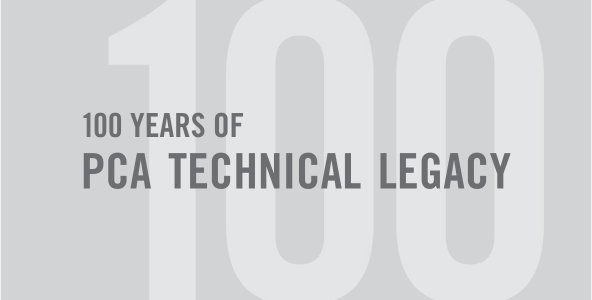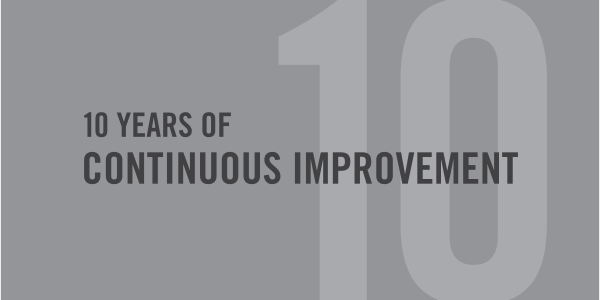
Founded in 1916, PCA launched its software development group in 1957 and reorganized it as StructurePoint in 2007.

The Portland Cement Association (PCA), the leading voice of the cement and concrete industry, began operations more than a century ago. At that time, concrete construction was rapidly expanding, and with it the need for reliable technical information, research, and education.
U.S. cement companies formed PCA “to raise the standard of concrete construction, to improve the quality of concrete work, to increase the quantity of cement used in established fields, and to develop new fields.”
Shortly after its founding, PCA and member companies adopted the slogan “Concrete for Permanence" for use on ads and other promotional materials. The promotional message would endure through the 1950s.
Early campaigns targeting buildings not only touted permanence and resilience, but also fire safety and benefits such as more windows and daylight.
In the late forties, PCA built the largest and best-equipped laboratory in the world devoted exclusively to cement and concrete materials. With the rising use of concrete for buildings, PCA followed up with expanded facilities for specialized research in fire safety and for testing large structural components.
The fire and structural labs enabled researchers to develop of more durable and economical buildings, refine architectural effects, and improve fire safety for concrete structures.

StructurePoint software originated almost sixty years ago as the Engineering Software Group (ESG) of the PCA. The group created software for in-house development of design aids and automatic calculations for Structural Engineers to simplify and speed up the analysis and design of reinforced concrete structures. The software was offered as a complimentary tool to market and improve perceptions of cement and concrete based structures. The programs were new, state-of-the-art and filled with the knowledge of experts while they ran on time-shared “super computers” in the basement of PCA. Using this new technology, leading engineers from notable firms pioneered the analysis and design of high rise concrete buildings shaping the skylines of major US cities.
By the 1960s, decades of PCA research alongside the launch of the ESG paid dividends in terms of gains in the high-rise building market. Complicated projects were completed more efficiently and the high rise market took off at a fast pace.
The ultimate-strength design concept developed by PCA greatly reduced the required size of concrete structural members. It placed concrete building frames in a highly competitive position with steel and extended the use of reinforced concrete to very tall buildings.
Concrete broke into the high-rise market with a string of record-breaking projects in Chicago:
1960: Chicago's Executive House Hotel was the tallest concrete building in the world at 36 stories and 385 feet tall.
1962: Chicago broke the 500-foot-high barrier for reinforced concrete buildings with the construction of Marina City designed by Bertrand Goldberg whose office historically utilized the technology.
1964: Chicago's One Thousand Lake Shore Drive took the crown, soaring 640 feet with 58 floors of luxury apartments.
1968: At 645 feet, Lake Point Tower, Chicago, became the world's tallest concrete building.
In the early 1980s, software progressed from a tool to facilitate and increase building with concrete to the essential tool of the structural engineering trade. By remaining technically focused, customer oriented and entrenched in PCA's historically research-driven legacy, the group continued to gain trust within the industry. However, operating in a small and increasingly competitive niche market of reinforced concrete, the group had to start generating enough revenues to support itself. Significant investment was needed to pursue better aesthetics, faster development, and highly specialized employees to sustain operations.
CTLGroup, an internationally recognized expert consulting engineering and materials science firm, originated as the cement and concrete technology Research and Development Laboratories of PCA. In 1987, the group was incorporated as Construction Technology Laboratories Inc., a subsidiary of PCA, and in 2005 began doing business as CTLGroup. Similarly to StructurePoint, the group remains at home on the PCA campus yet sustains and focuses independently on their niche set of solutions for the industry.
In 2003, the PCA Engineering Software Group reorganized and expanded as pcaStructurePoint with additional representation in Houston and made significant changes towards independence and self-sufficiency. As demand for this type of software skyrocketed, they were not only a department but a lucrative gateway for engineers in the cement and concrete industry. The group forged ahead with the ambitious management of trusted PCA Director of Engineering, Dr. Alsamsam. Though there were bumps in the road, Alsamsam believed in the success and sustainability of the powerful software.

Recognizing that a software group could flourish in their midst, PCA wanted to offer more space for growth and autonomy while providing transitional support and office space at the PCA campus. In 2007, under the direction of Dr. Alsamsam, pcaStructurePoint spun off to become an independent entity incorporated as StructurePoint LLC.
For many new companies, future success is full of uncertainty. However, the team knew that StructurePoint's success was guaranteed by its rich legacy and built into the structure of the software itself. The intellectual architecture created in 1958 was such high quality, well thought out and universally constructed that it would remain the state-of-the-art essential. StructurePoint took off towards success, improvement, and profitability from the outset of their new journey despite a devastating economic recession lasting several years.
Today, StructurePoint's global presence and committed clients not only support the operation, but they allow for a full office of professionals who work towards common goals and a shared, prolific vision each day. StructurePoint has become a trusted voice and reliable asset in the reinforced concrete industry in North America and beyond. Our team strengthens representation in India and the UAE and serves customers in over fifty countries spanning six continents.
StructurePoint's pragmatic, analytical clientele are not impressed with quick changes, frequent updates or frivolous bells and whistles. They are in it for the long run, some users for almost sixty years, and StructurePoint software is the primary tool they utilize to access their trade in more efficient and innovative ways. Our team of engineering technology professionals continues to develop and maintain their laser focus on their niche of reinforced concrete design. Instead of expanding in quantity, they delve deeper into quality to remain ahead in technical development, service, and resources.
As we celebrate our tenth anniversary, we look back on our rich hundred years of history. A seasoned expert filled with the energy of improvement, we move forward to new decades of global possibilities and continued progress. In the next ten, we will leverage our legacy to bring wider reach, more resources and further improvements to our core products. Most of all, we are excited to nurture and grow the relationships that mean the most to us: those with the structural engineers, architects, builders, professors, students, and more who have shaped communities and cities using StructurePoint software and whose gracious support has gotten us to where we are today.
As StructurePoint continues to build on its legacy of excellence, we proudly celebrated our 15th anniversary by embracing our Chicago roots and community spirit. To mark this occasion, we hosted a special gathering at the United Center, renting a box for a Chicago Bulls game. This event brought together our dedicated team members and their families, reinforcing the strong relationships that extend beyond the world of reinforced concrete design.
Just as our software empowers engineers to create safe and durable structures, this celebration strengthened the connections that have supported our journey, starting with PCA over a century ago. It was a night filled with excitement, camaraderie, and shared memories—highlighting not only our commitment to technical innovation but also our dedication to enriching the lives of those who have placed their trust in us to help shape cities' skylines and infrastructure around the globe.
StructurePoint moved its headquarters to the Innovation Park Business Center in Libertyville, Illinois, strategically positioning itself 30 miles north of downtown Chicago. With a growing global presence—including service representatives in India, Turkey, Jordan, Bolivia, and the United Arab Emirates—StructurePoint is poised to strengthen its international reach from this new, high-performance base of operations.
From 1957 to 2024, StructurePoint operated out of the Portland Cement Association (PCA) corporate campus in Skokie, Illinois. SP left its longtime location, following the sale and rezoning of the Skokie campus by PCA. The new headquarters in Libertyville positions SP at the heart of a vibrant business community, enhancing our ability to deliver cutting-edge solutions to clients worldwide.